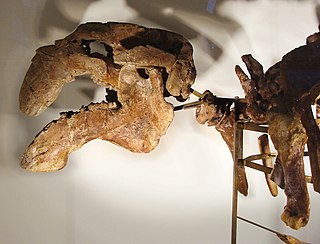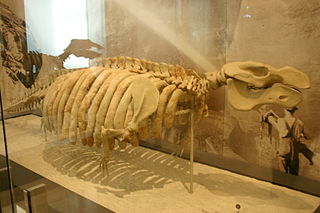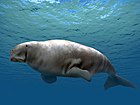
The Sirenia, commonly referred to as sea cows or sirenians, are an order of fully aquatic, herbivorous mammals that inhabit swamps, rivers, estuaries, marine wetlands, and coastal marine waters. The extant Sirenia comprise two distinct families: Dugongidae and Trichechidae with a total of four species. The Protosirenidae and Prorastomidae families are extinct. Sirenians are classified in the clade Paenungulata, alongside the elephants and the hyraxes, and evolved in the Eocene 50 million years ago (mya). The Dugongidae diverged from the Trichechidae in the late Eocene or early Oligocene.

Steller's sea cow is an extinct sirenian described by Georg Wilhelm Steller in 1741. At that time, it was found only around the Commander Islands in the Bering Sea between Alaska and Russia; its range extended across the North Pacific during the Pleistocene epoch, and likely contracted to such an extreme degree due to the glacial cycle. It is possible indigenous populations interacted with the animal before Europeans. Steller first encountered it on Vitus Bering's Great Northern Expedition when the crew became shipwrecked on Bering Island. Much of what is known about its behavior comes from Steller's observations on the island, documented in his posthumous publication On the Beasts of the Sea. Within 27 years of its discovery by Europeans, the slow-moving and easily-caught mammal was hunted into extinction for its meat, fat, and hide.

Hydrodamalis is a genus of extinct herbivorous sirenian marine mammals, and included the Steller's sea cow, the Cuesta sea cow, and the Takikawa sea cow. The fossil genus Dusisiren is regarded as the sister taxon of Hydrodamalis: together, the two genera form the dugong subfamily Hydrodamalinae. They were the largest member of the order Sirenia, whose only extant members are the dugong and the manatees. They reached up to 9 metres (30 ft) in length, making the Steller's sea cow among the largest mammals other than whales to have existed in the Holocene epoch. Steller's sea cow was first described by Georg Wilhelm Steller,

Hydrodamalinae is a recently extinct subfamily of the sirenian family Dugongidae. The Steller's sea cow was hunted to extinction by 1768, while the genus Dusisiren is known from fossils dating from the middle Miocene to early Pliocene.

Halitherium is an extinct dugongid sea cow that arose in the late Eocene, then became extinct during the early Oligocene. Its fossils are common in European shales. Inside its flippers were finger bones that did not stick out. Halitherium also had the remnants of back legs, which did not show externally. However, it did have a basic femur, joined to a reduced pelvis. Halitherium also had elongated ribs, presumably to increase lung capacity to provide fine control of buoyancy. A 2014 review presented the opinion that the genus is dubious.

Sirenia is the order of placental mammals which comprises modern "sea cows" and their extinct relatives. They are the only extant herbivorous marine mammals and the only group of herbivorous mammals to have become completely aquatic. Sirenians are thought to have a 50-million-year-old fossil record. They attained modest diversity during the Oligocene and Miocene, but have since declined as a result of climatic cooling, oceanographic changes, and human interference. Two genera and four species are extant: Trichechus, which includes the three species of manatee that live along the Atlantic coasts and in rivers and coastlines of the Americas and western Africa, and Dugong, which is found in the Indian and Pacific oceans.

Eotheroides is an extinct genus of Eocene sirenian. It is an early member of the family Dugongidae, which includes the extant dugong. Fossils have been found from Egypt, India, and Madagascar. Eotheroides was first described by Richard Owen in 1875 under the name Eotherium, which was replaced by the current name in 1899.

Metaxytherium is an extinct genus of dugong that lived from the Oligocene until the end of the Pliocene. Fossil remains have been found in Africa, Europe, North America and South America. Generally marine seagrass specialists, they inhabited the warm and shallow waters of the Paratethys, Mediterranean, Caribbean Sea and Pacific coastline. American species of Metaxytherium are considered to be ancestral to the North Pacific family Hydrodamalinae, which includes the giant Steller's Sea Cow.

Nanosiren garciae is an extinct sirenian dugong that lived in warm shallow seas in what is now Venezuela, approximately 11.610—3.6 Ma during the Miocene and Pliocene. The species is listed in the Paleobiology Database, funded by the Australian Research Council.
The Chandler Bridge Formation is a geologic formation in South Carolina. It preserves fossils dating back to the Chattian of the Paleogene period, corresponding to the Arikareean in the NALMA classification. The formation overlies the Ashley Formation and is overlain by the Edisto Formation.
The Lares Limestone is a geologic formation in Puerto Rico. It preserves fossils dating back to the Late Oligocene to Early Miocene period.

Dusisiren is an extinct genus of dugong related to the Steller's sea cow that lived in the North Pacific during the Neogene.

The Cuesta sea cow is an extinct herbivorous marine mammal and is the direct ancestor of the Steller's sea cow. They reached up to 9 metres (30 ft) in length, making them among the biggest sirenians to have ever lived. They were first described in 1978 by Daryl Domning when fossils in California were unearthed. Its appearance and behavior are largely based on that of the well-documented Steller's sea cow, which, unlike the Cuesta sea cow, lived into modern times and was well-described.
The Takikawa sea cow is an extinct herbivorous marine mammal of the Late Pliocene which was closely related to the recently extinct Steller's sea cow. In 1988, fossils of sea cows were discovered in Hokkaido and were originally assigned to the Takikawa sea cow, a newly described species, even though this taxon is thought of by some scientists as a synonym of the Cuesta sea cow. It is uncertain whether or not the Takikawa sea cow was simply a local variant of the Cuesta sea cow or a completely separate lineage. However, the Steller's sea cow and Takikawa sea cow share more morphological similarities than the Takikawa sea cow and Cuesta sea cow.

Lentiarenium was an early sea cow from the Late Oligocene (Chattian) Linz-Melk Formation of Austria. Known since the mid 19th century, Lentiarenium was long considered to be a species of Halitherium until a 2016 analysis showed it to be distinct.
Italosiren is an extinct genus of early dugong from the Early Miocene (Aquitanian) Libano Formation in northern Italy.
Priscosiren is an extinct genus of mammal which existed in the west Atlantic and Puerto Rico during the early Oligocene (Chattian).

Crenatosiren is an extinct genus of dugongid sirenian known from the late Oligocene (Chattian) of Florida, North Carolina, and South Carolina. The type and only known species is Crenatosiren olseni.

Dioplotherium is an extinct genus of mammal known from Neogene deposits in the southeastern United States.

Stegosiren was an early sea cow from the Middle Oligocene of South Carolina, US. It shows a stage of halitheriine evolution more derived than that of the Old World early Oligocene Eosiren imenti and Halitherium schinzii.
















